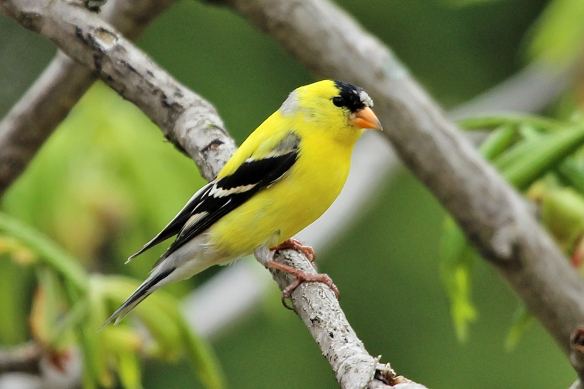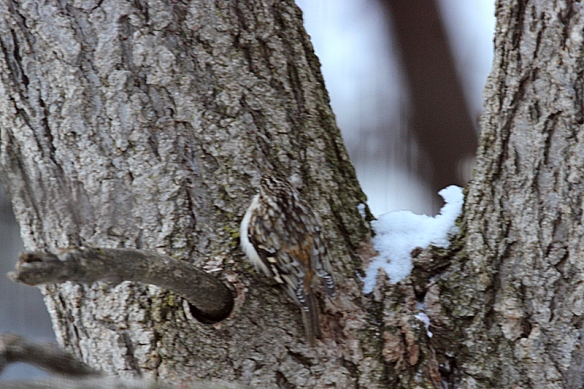I see that my bird classification skills are sadly out of date. Today I found out that the Indigo Bunting is grouped with the Cardinals, Rose-breasted and Black-headed Grosbeaks, and Flame, Scarlet, and Hepatic Tanagers. How confusing! For some reason, I have always lumped little birds with conical (finchy) bills into one group, when in fact, there are definitely two: finches and sparrows (and then of course, one can further split those two categories into old world (Europe-Asia) and (New World – Americas), but I won’t go there in this post.
So, here’s the low-down on what to call the little finch-like birds in your garden. (Like all rules, there are, of course, exceptions to these generalities.)
1) If the male is brightly colored in his summer plumage but the female duller, resembling the winter plumage, the species is likely to be a finch, e.g., Goldfinch, House Finch, etc.

This male hasn’t quite finished decking himself out in yellow and black, but he’s close.

Male House Finches really stand out at this time of year.

Female House Finches have some nice stripes, but lack the brilliant red accent colors of the male.
2) Sparrows of both sexes sport a mottled brown, black, and white plumage that blends in nicely with their preferred grassy habitat. Only the juvenile (first year after hatch) birds look different than the adult plumage.

This Swamp Sparrow was singing up a storm, but it was hard to locate him among the dead cattail stems and grasses.

Male and female White-throated Sparrows look identical, but the first year birds have brown head stripes and lack the yellow spot above the eye.
3) Typically, sparrows feed mostly on the ground, scratching under the litter for seeds or insects, while finches are more arboreal, searching for food on the seed heads of perennial grasses, thistles, etc.

Even though there is a feeder full of delicious finch seed right above this bird’s head, it prefers to look in the grass for fallen kernels rather than perch on the feeder.

A photo from last summer illustrates the plumage difference between male and female Goldfinches, as well as their preference for perching on the flower heads to harvest the seed.
4) It may be difficult to see differences in the shape and size of their bills, but finches generally have a stouter, thicker bills for their body size than sparrows. That rule seems to work if you compare House Finch bills to those of Swamp Sparrows, but it looks like White-throated Sparrows have a pretty thick bill as well.
As I said above, there are exceptions to every rule…but at least I won’t be calling all seed-eating birds sparrows now without thinking about it first.























